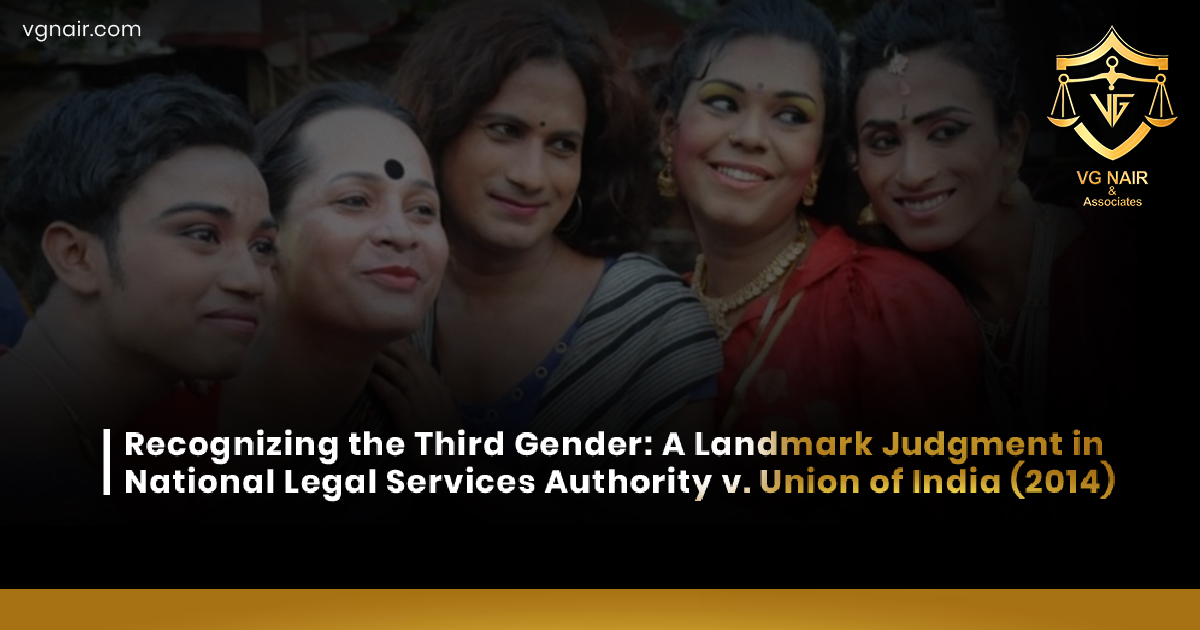Recognizing the Third Gender A Landmark Judgment in National Legal Services Authority v Union of India

The 2014 judgment by the Supreme Court of India in National Legal Services Authority v. Union of India stands as a monumental stride towards gender equality in the country. This landmark ruling recognized transgender individuals as the 'third gender' and affirmed their fundamental rights, including the right to self-identify their gender and access equal opportunities under the Indian Constitution. This decision marked a pivotal moment in the fight for transgender rights, as it granted them the right to self-identify their gender as male, female, or third gender, thereby fostering a more inclusive society.
The petitioners and the judicial bench
The National Legal Services Authority of India (NALSA), a group founded to offer free legal assistance to underprivileged groups in society, was the main petitioner in this case. Joining NALSA were the Poojya Mata Nasib Kaur Ji Women Welfare Society, an NGO committed to women's welfare, and Laxmi Narayan Tripathy, a well-known Hijra activist recognized for her support of transgender rights.
A two-judge panel comprising Justices K.S. Panicker Radhakrishnan, a seasoned advocate for social justice, and Arjan Kumar Sikri, a renowned legal scholar, decided the case. The two justices demonstrated meticulous analysis by actively engaging with testimonies from transgender individuals and experts, showcasing their deep understanding of the issues and unwavering dedication to social justice.
Key Directives of the Judgment
- Legal Recognition of the Third Gender: The Court's decision to legally recognize the third gender was a groundbreaking affirmation of the fundamental rights of transgender individuals. By acknowledging the third gender, the Court ensured that transgender people could enjoy the same rights as their male and female counterparts. The judgment also highlighted the discriminatory nature of non-recognition in various legal contexts, such as marriage, adoption, and divorce.
- Self-Identification of Gender: The Supreme Court emphasized the importance of self-identification of gender, opting for a 'psychological test' over a 'biological test' for recognizing gender identity. This progressive stance declared that insisting on sex reassignment surgery (SRS) as a prerequisite for gender change is illegal.
- Public Health and Sanitation: Recognizing the unique healthcare needs of transgender individuals, the Court directed both the central and state governments to provide adequate medical care in hospitals and to establish separate public toilets and other facilities.
- Socio-Economic Rights: The judgment acknowledged the socio-economic disadvantages faced by the transgender community and directed governments to treat them as socially and economically backward classes. This classification entitles them to reservations in educational institutions and public appointments, aiming to improve their access to opportunities and resources.
- Addressing Stigma and Raising Public Awareness: The Court called for extensive public awareness campaigns to combat stigma and promote the social integration of transgender individuals. These campaigns are crucial for addressing issues like fear, shame, gender dysphoria, depression, and suicidal tendencies and for restoring the respect and dignity of transgender people in society.
Implementation and Impact
The Supreme Court's directives have profound implications for the legal and social standing of transgender individuals in India. Regular audits and digitization of records were also ordered to ensure transparency and accountability in managing the implementation of transgender rights measures.
The Court's judgment underscores the importance of treating transgender individuals with dignity and respect, aligning with the recommendations of the Ministry of Social Justice and Empowerment's Expert Committee Report on transgender issues.
Conclusion
The National Legal Services Authority v. Union of India (2014) judgment is a landmark in the history of transgender rights in India. By legally recognizing the third gender and ensuring their fundamental rights, the Supreme Court has paved the way for greater acceptance and integration of transgender individuals into mainstream society. This ruling not only addresses the immediate needs of the transgender community but also sets a precedent for future legal and social advancements in areas such as healthcare access, employment opportunities, and educational inclusivity in the quest for gender equality.
